Siksika Nation
 | |
| People | Blackfoot |
|---|---|
| Treaty | Treaty 7 |
| Headquarters | Siksika |
| Province | Alberta |
| Land[1] | |
| Reserve(s) | |
| Land area | 710.875 km2 |
| Population (2020)[1] | |
| On reserve | 4120 |
| On other land | 2 |
| Off reserve | 3412 |
| Total population | 7534 |
| Government[1] | |
| Chief | Ouray Crowfoot |
| Tribal Council[1] | |
| Samuel Crowfoot, Reuben Breaker, Ike Solway, Candace Backfat, Carlin Black Rabbit, Kendall Panther Bone, Lou Ann Soloway, Hector Winnipeg, Strater Crowfoot, Marsha Wolf Collar, Owen Crane Bear, and Tracy McHugh. | |
| Website | |
| siksikanation.com | |
The Siksika Nation (Blackfoot: Siksiká; syllabics ᓱᖽᐧᖿ) is a First Nation in southern Alberta, Canada. The name Siksiká comes from the Blackfoot words sik (black) and iká (foot), with a connector s between the two words. The plural form of Siksiká is Siksikáwa. The Siksikáwa are the northernmost of the Niitsítapi (Original People), all of whom speak dialects of Blackfoot, an Algonquian language.
When European explorers travelled west, they most likely met the Siksiká first. The four Niitsítapi nations of the Blackfoot Confederacy are the Siksiká, Káínaa (Kainai or Blood), Aapátohsipikáni (Northern Peigan), and Aamsskáápipikani (South Peigan or Montana Blackfoot). The population of the Siksika Nation is approximately 7,800 people.[2]
Economic and social stimulus
[edit]Siksika Resource Development Limited
[edit]The Siksika nations economic authority is the Siksika Resource Development Limited (SRDL) founded in 1997. They manage a diverse group of enterprises and properties.
SRDL applied for a licence to produce Medical Marijuana in April 2016. They anticipate generating $15M in annual revenue. The Siksika Resource Development Ltd, and Siksika Herbz Ltd, and Frozen Penguin Ltd of Kelowna BC partnership plan to construct 25,000 Sq ft facility on the Siksika Nation. Revenue generated will also be donated to support social services.
The Siksika intend to distribute the medication domestically and internationally. Revenue from the venture is intended to address disparaging economic issues such as Opioid addiction epidemic, and housing. As of 2020 the proposal is still under review. Frozen Penguin will use modern technology and techniques such as 'RotoGro', to maximize profits for the nation.[3][4]
On July 16, 2022. SRDL partnered with 'Calgary Tree Planting Team' volunteers to plant 300 Sakskatoon berry trees near the "Siksika business Plaza". The initiative will increase food security and provide economic growth for the Nation.[5]
Siksika Family Services Corporation/Siksika Children's Services
[edit]The Siksika Family Services was awarded a grant by the Provincial and Federal governments 'Rapid Housing Initiative', to establish a transitional 24 housing unit community for Siksika's vulnerable high need families and youth in the process of cultural reunification. The community will be called "Children's Village".[6]
Location
[edit]The Siksika Nation reserve, Siksika 146, is located approximately 95 km (59 mi) east of Calgary, and 3 km (1.9 mi) south of the Trans Canada Highway (Highway 1). Its administrative and business district is located adjacent to the community of Gleichen.
Siksika Nation is the second largest, land-based, in Canada. Siksika Nation Boundaries of Blackfoot Confederacy Traditional Territory. North-North Saskatchewan River, West – Rock Mountains, East-At the confluence of the North and South Saskatchewan Rivers and South-Yellowstone River.
Land claims
[edit]
The Siksika Nation has had a longstanding land claim dispute with the Government of Canada over events dating back to 1910. The government sought the cession of approximately 46,621.4 hectares (115,204 acres) of land within the Siksika Indian Reserve for sale by the federal government to incoming settlers. The cession included 5,067.6 hectares (12,522 acres) of reserve lands to be transferred to the Canadian Pacific Railway, for construction of the Bassano Dam. The band members were not adequately informed about this portion and lost the use of the surface rights of the land. The Nation claims the transfer was done illegally. In 1980, the government admitted that no proof existed that Canadian Pacific had acquired the rights to the land for the dam.[7]
The Nation entered into negotiations with the Canadian government to settle the land claim. In 1991, the Siksika Nation signed a $4.9m agreement with the government for compensation for mineral rights lost due to construction of the dam. In 2010, the Nation finally reached agreement with the governments of Canada and Alberta to settle the land claims. The band would receive $50 million and new water rights.[7] The money will be put in a trust to benefit the Nation for purposes such as education and welfare.
2021 Global Settlement Agreement
[edit]A six decade process of land claims commenced in 1960 under the leadership of Siksika Chief Clarence McHugh in 1959. McHugh stated “They told us they would give us a bag of money which would never empty, but somehow, that bag developed a great big hole.” In reference to the late Minister of the Interior, Frank Oliver who was instrumental in the disembowelment of 289,897 acres of First Nation's territorial integrity throughout his career. He advised First Nations to cede/surrender treaty territory throughout Canada in exchange for frequently reneged Federal concessions or cohesion such as denial of necessities such as food. He told the Siksika: "It might be better to sell what they do not use for a big bag of money, which could give them money for ever and ever!". Chief McHugh described the surrendering as '“They cut our reserve up like a Christmas turkey and wasted our money.”[8] A reporter described the dwellings of the Siksika as being "ramshackle, uninsulated houses without foundations, with cracks and broken windows, patched up with rags and cardboard" and Chief McHugh described the houses built after the initial sale in 1912 as "almost falling apart".
In December 2021, Siksika members voted in a referendum to ratify the "Global Settlement Agreement", 3,484 turned out to vote and of them 77% (2,682 people) voted for ratification. A comprehensive resolution followed, resolving multiple land claims and associated grievances which included a one-time payment of 1.3 Billion dollars and entitlement to purchase 115,000 acres of land from willing sellers which had previously been illegally obtained from the tribe through the so-called "1910 Surrender".[9]
On June 2, 2022, in a ceremony at the Blackfoot Crossing Historical Park, the Canadian government and the Siksika Nation signed the "Global Settlement Agreement". The conclusion of a 60 year process of ongoing negotiations to redress the numerous land claims of previous illegal annexations and settlement of 115,000 acres (465.4 kmsq) of productive agricultural, ceremonial, and mineral reserve territory and the non-payment of mineral royalties following the "1910 Surrender".[10]
$20,000 was given to each band member and to essential services for the community such as improving education, infrastructure, and mental health services. As well as to fund a permanent police force for the reservation.[11]
Notable people
[edit]- Ouray Crowfoot, Chief of the Siksika Nation (c. 2019). Signer of the '1910 Global Settlement Agreement'.
- Crowfoot, chief of the Siksika Nation (c. 1885) and a signer of Treaty 7.
- Aatsista-Mahkan (Running Rabbit), portrayed in photo by Edward S. Curtis.
- Robin Big Snake, former professional hockey player, most recently with the Muskegon Lumberjacks during the 2009-10 International Hockey League season.
- Armond Duck Chief, country singer and songwriter.
- Gerald McMaster, artist, curator, and author.
- Adrian Stimson, interdisciplinary artist, 2018 Governor's General award winner in visual and media arts.
- Maggie Black Kettle, storyteller, educator, dancer, actress, community leader
Chief and council
[edit]Ouray Crowfoot, Samuel Crowfoot, Reuben Breaker, Ike Solway, Owen Crane Bear, Candace Backfat, Carlin Black Rabbit, Kendall Panther Bone, Hector Winnipeg, Strater Crowfoot, Marsha Wolf Collar, and Tracy McHugh.
Chief and council staff
[edit]Mariah Little Chief, Sharon Brass, Erica Sitting Eagle, and Allison Duck Chief.
Tribal administration
[edit]Richard Sparvier, Van Le, Tom Many Heads, and Hossam Yaqoub.
Gallery
[edit]-
Sahpo Muxika / Issapóómahksika / ᖱᓭᑲᒉᖽᐧᖿᖷ , also known as Crowfoot, Head Chief of the Siksika, c. 1885
-
Curly Bear, a Siksika chief, 1903
-
Aatsista-Mahkan, circa 1900, by Edward S. Curtis
-
Gerald McMaster, 2009
References
[edit]- ^ "First Nation Detail". Crown–Indigenous Relations and Northern Affairs Canada. Government of Canada. Retrieved September 10, 2019.
- ^ "About Siksika Nation". siksikanation.com. Retrieved January 16, 2024.
- ^ Brooks, A (Nov 4. 2016) 'Siksika Nation eyes pot production facility'.Calgary Sun, Retrieved from http://www.calgarysun.com/2016/11/04/siksika-nation-eyes-pot-production-facility, Retrieved on November 7, 2016
- ^ Firs Nations Drum (2019, May.24) 'http://www.firstnationsdrum.com/2019/05/siksika-nation-enters-cannabis-business/', First Nations Drum.
- ^ "First steps to a Siksika Saskatoon berry farm". StrathmoreNow. Retrieved December 21, 2023.
- ^ Tremblay, D.B.(2022, May 4)'New housing project for high risk families in Siksika First Nation', retrieved from https://www.cjwe.ca/news/news/new-housing-project-for-high-risk-families-in-siksika-first-nation/, Retrieved July 8, 2022.
- ^ a b Kelly Clyderman (December 12, 2010). "Deal would give native band over $50 million in land dispute". Montreal Gazette. Archived from the original on December 16, 2010. Retrieved December 24, 2010.
- ^ Carter,S.(2021, Dec 31).' Opinion: 63 Years Later — The Siksika Land Claim Settlement Finally Settled', Calgary Herald, retrieved from https://calgaryherald.com/opinion/editorials/opinion-63-years-later-the-siksika-land-claim-settlement-finally-settled/
- ^ "Siksika Nation members accept the Global Settlement Agreement". December 12, 2023. Retrieved December 21, 2023.
- ^ "Major historical claim settlement with Siksika Nation". Prime Minister of Canada. June 2, 2022. Retrieved December 21, 2023.
- ^ "Siksika First Nation $1.3B land claim settlement addresses injustices of the past". calgary.citynews.ca. Retrieved December 21, 2023.





